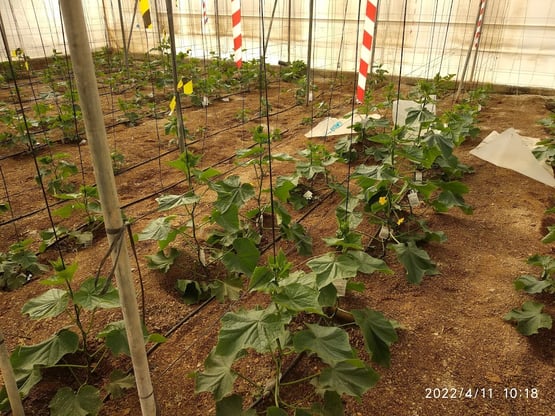Biosabor, a distributor of Moleaer's nanobubble technology in Spain, together with Cajamar, a leading institution and research center in the agriculture sector in Spain for research and innovation, studied the effects of nanobubble-enriched irrigation water on greenhouse cucumbers grown in sandy soil under semi-controlled temperature and humidity conditions.
Moleaer’s nanobubble technology economically supersaturates irrigation water with dissolved oxygen and injects hundreds of millions of electrochemically charged nanobubbles that alter the properties of water to deliver multiple benefits.
Increased dissolved oxygen levels maximize oxygen utilization by plants and beneficial microbes in the rhizosphere, promoting healthy root development and improving plants’ resilience to environmental stressors such as drought and heat.

High concentrations of negatively charged nanobubbles reduce the surface tension of water and improve the infiltration of soils as well as improve the capillary action of dissolved nutrients to get nutrients and water to the root zone where they are needed most.
Better capillary root mass results in more efficient nutrient uptake, allowing for improved fruit size without sacrificing nutrient content or brix. This was validated in a recent study by NovaCropControl on greenhouse peppers. The study concluded that nanobubbles improved root mass by 25%, which lead to a 30% increase in 1st-class fruit.
Another study published in the Journal of Cleaner Production validated that nanobubble oxygenation improved irrigation water use efficiency, crop yield and quality in tomato and cucumber plants.
Nanobubbles also produce a natural, mild oxidant when they encounter contaminants in the water, reducing water-borne pathogens and algae without chemicals. Their hard, stable shell allows them to abrade biofilm and scale from irrigation systems and coat piping walls to limit new accumulation – improving system hygiene and reducing treatment costs. To test these benefits of nanobubble technology in greenhouse cucumbers, Biosabor and Cajamar used a control group with untreated water and compared it to a group grown with nanobubble-enriched irrigation water.
During Biosabor’s study, several crop parameters were measured. The DO concentrations were measured by an optical oximeter both in the recirculation tank and at the dripper emitters. The weight, length, and center perimeter of the fruit were measured, as well as the number of fruit per plant. The fruit was classified by categories according to their quality: 1st Class, 2nd Class and Low Quality which could not be used commercially.
The DO concentration in the nutrient solution with nanobubbles ranged from 43.8 mg/L at the beginning of the crop cycle to 34.6 mg/L at the end, which was significantly higher than the control group which was consistently below 10 mg/L. The gradual decrease in this DO concentration was attributed to the increase in temperature throughout the experiment.
During the second period of the study, the nanobubble-enriched irrigation water kept the production rate more consistent than the control treatment, which led to notable differences in both total and commercial production.
Both total and commercial fruit production were significantly higher in the group irrigated with nanobubble-enriched irrigation water. Crop quality improved with a considerable yield increase of first-class fruit (7.23 kg/m2 vs. 6.11 kg/m2) and a slightly higher average weight per fruit (403.5 gr vs. 392.6 gr).

Treatment with nanobubbles led to a higher accumulation of nitrogen and potassium in the fruit. This indicates a more efficient uptake of nutrients by the crop Caused by nanobubbles’ ability to mobilize nutrients in the soil and facilitate absorption by the root system.
Pablo Garcia Raya, Agronomy Engineer at Biosabor stated:
“The use of oxygen nanobubbles in greenhouse crops has improved the production in cucumber and tomato crops under conditions of high temperature. This technology has allowed for increased production in suboptimal conditions for the development of the crop, improving the profitability of the farm and optimizing the use of water and other inputs."
It was concluded that nanobubble-enriched irrigation water improved greenhouse cucumber cultivation, leading to more fruit production and better-quality cucumbers.

Nanobubble technology helped the grower:
Growers looking to increase crop quality can adopt nanobubble-enriched irrigation for a sustainable and affordable solution. The benefits of irrigation crops with oxygen nanobubbles can lead to more profitability from increased production and fruit quality. Higher quality fruit means more commercial value and often increased profit.
Download Now